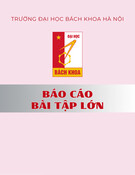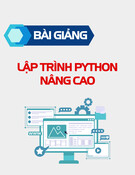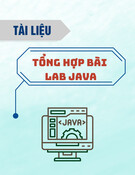ƯỜ Ạ Ọ Ệ TR NG Đ I H C NÔNG LÂM TP.HCM KHOA CÔNG NGH THÔNG TIN
H N I V N Â U X N Ễ Y U G N
:
V G
EJB: Entity Bean
2 G N Ạ M H N Ì R T P Ậ L
:
N Ô M
6 1
/
1 0
/
5 1
ễ
X X
/
1
Presenter: Nguy n Xuân Vinh Information Technology Faculty Nong Lam University
ƯỜ Ạ Ọ Ệ TR NG Đ I H C NÔNG LÂM TP.HCM KHOA CÔNG NGH THÔNG TIN
Session Objectives
H N I V N Â U X N Ễ Y U G N
:
V G
2 G N Ạ M H N Ì R T P Ậ L
Describe the concept of persistence. Define entity beans. List the features offered by entity beans. Compare entity and session beans. Explain MessageDriven Beans.
:
N Ô M
6 1
/
1 0
/
5 1
X X
/
2
ACCP2005/EJB 2.0/ Session 5 / 2 of 33
ƯỜ Ạ Ọ Ệ TR NG Đ I H C NÔNG LÂM TP.HCM KHOA CÔNG NGH THÔNG TIN
Review of Session 4
H N I V N Â U X N Ễ Y U G N
:
V G
In Session 4 we discussed: Definition of a Stateful Session Bean. The characteristics of a Stateful Session Bean. How to program Stateful session beans. Difference between Stateless and Stateful Session beans.
2 G N Ạ M H N Ì R T P Ậ L
:
N Ô M
6 1
/
1 0
/
5 1
X X
/
3
ACCP2005/EJB 2.0/ Session 5 / 3 of 33
ƯỜ Ạ Ọ Ệ TR NG Đ I H C NÔNG LÂM TP.HCM KHOA CÔNG NGH THÔNG TIN
Persistence
H N I V N Â U X N Ễ Y U G N
:
V G
Storage
Java Object Serialization
Persistence Objects
Database
Obj 1
Storage
Object database Persistence
2 G N Ạ M H N Ì R T P Ậ L
:
Persistence
N Ô M
Obj 2
Storage
6 1
/
Object Relational Mapping
1 0
/
5 1
Three ways to make an object persistent
X X
/
4
ACCP2005/EJB 2.0/ Session 5 / 4 of 33
ƯỜ Ạ Ọ Ệ TR NG Đ I H C NÔNG LÂM TP.HCM KHOA CÔNG NGH THÔNG TIN
Java Object Serialization
H N I V N Â U X N Ễ Y U G N
:
V G
Marshall an object graph into a compact representation
Object 1
Compact representation
State of the object
Object 2
2 G N Ạ M H N Ì R T P Ậ L
:
N Ô M
Serialization of object graph into byte stream
Object n
6 1
/
1 0
/
Developer pushes data over the network or saves the stream to a storage
5 1
Byte Stream
X X
/
5
ACCP2005/EJB 2.0/ Session 5 / 5 of 33
ƯỜ Ạ Ọ Ệ TR NG Đ I H C NÔNG LÂM TP.HCM KHOA CÔNG NGH THÔNG TIN
Object Relational Mapping
H N I V N Â U X N Ễ Y U G N
:
V G
Travel Account
Manual Mapping
Database API
String Name String TktNo Double Amount
Use an Object- Relational Mapping Product
2 G N Ạ M H N Ì R T P Ậ L
Object
:
N Ô M
6 1
/
Relational Database
1 0
/
5 1
X X
/
6
ACCP2005/EJB 2.0/ Session 5 / 6 of 33
ƯỜ Ạ Ọ Ệ TR NG Đ I H C NÔNG LÂM TP.HCM KHOA CÔNG NGH THÔNG TIN
Object Database Persistence
H N I V N Â U X N Ễ Y U G N
:
V G
Object database persistence is designed to store Java Objects as whole objects which means that there is no need to program a relational database.
The Object Query Language (OQL) provides the facility to
query the persisted objects.
2 G N Ạ M H N Ì R T P Ậ L
:
This language adds a layer of abstraction from the
N Ô M
relational database queries.
6 1
/
1 0
/
5 1
The EJB QL eliminates the inconsistencies caused due to the use of the different Query languages used by different application servers.
X X
/
7
ACCP2005/EJB 2.0/ Session 5 / 7 of 33
ƯỜ Ạ Ọ Ệ TR NG Đ I H C NÔNG LÂM TP.HCM KHOA CÔNG NGH THÔNG TIN
Components deployed in Multi-tier Deployment- Application logic components
H N I V N Â U X N Ễ Y U G N
:
V G
Application logic components are components that provide methods which perform common tasks
2 G N Ạ M H N Ì R T P Ậ L
:
N Ô M
6 1
/
1 0
/
5 1
Billing of products
Computing the price of a ticket
X X
/
8
ACCP2005/EJB 2.0/ Session 5 / 8 of 33
ƯỜ Ạ Ọ Ệ TR NG Đ I H C NÔNG LÂM TP.HCM KHOA CÔNG NGH THÔNG TIN
Components deployed in Multi-tier Deployment - Persistent Data Components
H N I V N Â U X N Ễ Y U G N
:
V G
Object
Database
Serialization of data
2 G N Ạ M H N Ì R T P Ậ L
:
Employee data such as salaries and place of work
N Ô M
Examples are air ticket information such as ticket number and amount
6 1
/
1 0
/
5 1
X X
/
9
ACCP2005/EJB 2.0/ Session 5 / 9 of 33
ƯỜ Ạ Ọ Ệ TR NG Đ I H C NÔNG LÂM TP.HCM KHOA CÔNG NGH THÔNG TIN
Files in an Entity bean
H N I V N Â U X N Ễ Y U G N
:
V G
Entity Bean Class
Remote Interface
2 G N Ạ M H N Ì R T P Ậ L
:
Entity Bean
Deployment Descriptors
N Ô M
6 1
/
1 0
/
Home Interface
5 1
X X
/
Primary Key Class
Local Interfaces
0 1
ACCP2005/EJB 2.0/ Session 5 / 10 of 33
ƯỜ Ạ Ọ Ệ TR NG Đ I H C NÔNG LÂM TP.HCM KHOA CÔNG NGH THÔNG TIN
Entity Bean class
H N I V N Â U X N Ễ Y U G N
:
Maps
V G
Models
Persistent Data
Java Class
2 G N Ạ M H N Ì R T P Ậ L
:
Database Schema
N Ô M
6 1
/
1 0
Entity Definition
/
For example, an entity bean class can map to a relational table definition. An entity bean instance of that class will then map to a row in that table.
5 1
X X
/
1 1
ACCP2005/EJB 2.0/ Session 5 / 11 of 33
ƯỜ Ạ Ọ Ệ TR NG Đ I H C NÔNG LÂM TP.HCM KHOA CÔNG NGH THÔNG TIN
The Entity Bean’s Remote Interface
H N I V N Â U X N Ễ Y U G N
:
V G
Client
Entity Bean
2 G N Ạ M H N Ì R T P Ậ L
:
Remote Invokes Interface Business Method signatures
N Ô M
6 1
/
1 0
/
5 1
X X
/
2 1
ACCP2005/EJB 2.0/ Session 5 / 12 of 33
ƯỜ Ạ Ọ Ệ TR NG Đ I H C NÔNG LÂM TP.HCM KHOA CÔNG NGH THÔNG TIN
The Home Interface
H N I V N Â U X N Ễ Y U G N
:
create
V G
Entity Bean Object
Home Interface
Uses
find
Client
Entity Bean Object
Methods
2 G N Ạ M H N Ì R T P Ậ L
:
destroy
N Ô M
Entity Bean Object
6 1
/
1 0
/
5 1
The home interface is used by the clients to create, find and destroy entity bean objects.
X X
/
3 1
ACCP2005/EJB 2.0/ Session 5 / 13 of 33
ƯỜ Ạ Ọ Ệ TR NG Đ I H C NÔNG LÂM TP.HCM KHOA CÔNG NGH THÔNG TIN
Local Interface
H N I V N Â U X N Ễ Y U G N
:
V G
Local Clients
Entity Beans
Exposes
2 G N Ạ M H N Ì R T P Ậ L
Entity Beans
:
N Ô M
Methods
6 1
/
1 0
/
Container
5 1
X X
/
4 1
Local Interface allows the beans to expose its methods to other beans that reside within the same container (local clients). ACCP2005/EJB 2.0/ Session 5 / 14 of 33
ƯỜ Ạ Ọ Ệ TR NG Đ I H C NÔNG LÂM TP.HCM KHOA CÔNG NGH THÔNG TIN
The Primary Key Class
H N I V N Â U X N Ễ Y U G N
:
V G
Primary keys make each entity bean look different. A primary key is an object itself which contains other objects and data that is necessary to identify an entity bean data instance.
The primary key class has to be serializable, and has
2 G N Ạ M H N Ì R T P Ậ L
:
to follow the rules of Java object serialization.
N Ô M
The unique identifier, or primary key, enables client to
locate the particular entity bean.
6 1
/
1 0
/
5 1
X X
/
5 1
ACCP2005/EJB 2.0/ Session 5 / 15 of 33
ƯỜ Ạ Ọ Ệ TR NG Đ I H C NÔNG LÂM TP.HCM KHOA CÔNG NGH THÔNG TIN
The Deployment Descriptors
H N I V N Â U X N Ễ Y U G N
:
V G
Contacts the deployment descriptor for bean deployment
Container
Deployment descriptors
2 G N Ạ M H N Ì R T P Ậ L
:
N Ô M
List of properties
6 1
/
Informs the container about the bean and classes
1 0
/
5 1
X X
/
6 1
ACCP2005/EJB 2.0/ Session 5 / 16 of 33
ƯỜ Ạ Ọ Ệ TR NG Đ I H C NÔNG LÂM TP.HCM KHOA CÔNG NGH THÔNG TIN
Pooling of Entity Bean Instances
H N I V N Â U X N Ễ Y U G N
:
V G
Represents
Instantiates
Storage
EJB
Entity Entity Bean 1 Bean 1
Data 1
Container
Data 2
Entity Bean 2
Data n
2 G N Ạ M H N Ì R T P Ậ L
:
N Ô M
Entity Bean n
Entity Beans
6 1
/
1 0
/
5 1
Pooled and Recycled
X X
/
When the bean instance is used ,it is assigned to handle different client request.
7 1
ACCP2005/EJB 2.0/ Session 5 / 17 of 33
ƯỜ Ạ Ọ Ệ TR NG Đ I H C NÔNG LÂM TP.HCM KHOA CÔNG NGH THÔNG TIN
Ways to Persist Entity Beans
H N I V N Â U X N Ễ Y U G N
:
V G
Bean-managed Persistence
Entity Bean
Entity Beans map themselves in the data store
:
Data Store
2 G N Ạ M H N Ì R T P Deployment Descriptor tells the Ậ L container about the persistent fields N Ô and then the container handles the data logic M
6 1
/
1 0
/
5 1
Deployment Descriptor
Container- Managed Persistence
X X
/
8 1
ACCP2005/EJB 2.0/ Session 5 / 18 of 33
Persistent Beans
ƯỜ Ạ Ọ Ệ TR NG Đ I H C NÔNG LÂM TP.HCM KHOA CÔNG NGH THÔNG TIN
Working with Entity Beans
The entity bean instance and the underlying database can be
considered as one and the same.
H N I V N Â U X N Ễ Y U G N
:
When the beanmanaged persistent bean calls the ejbCreate()
V G
method, it creates the database data.
In case of containermanaged persistence, the container contains required data access logic, leaving the bean’s methods empty of data access logic.
The finder methods are used to find the existing entity bean in
2 G N Ạ M H N Ì R T P Ậ L
:
storage. The finder methods do not create any new database data, but they load old entity bean data.
N Ô M
6 1
/
1 0
/
5 1
X X
/
9 1
ACCP2005/EJB 2.0/ Session 5 / 19 of 33
ƯỜ Ạ Ọ Ệ TR NG Đ I H C NÔNG LÂM TP.HCM KHOA CÔNG NGH THÔNG TIN
Modifying Entity Beans Directly though the Database
H N I V N Â U X N Ễ Y U G N
:
V G
EJB Container/ Server
Entity Beans Existing Application
2 G N Ạ M H N Ì R T P Ậ L
O/R Mapping
:
N Ô M
Direct Database Modifications
Bean data
6 1
/
1 0
/
5 1
X X
/
0 2
ACCP2005/EJB 2.0/ Session 5 / 20 of 33
Database
ƯỜ Ạ Ọ Ệ TR NG Đ I H C NÔNG LÂM TP.HCM KHOA CÔNG NGH THÔNG TIN
Developing and Using Entity Beans
H N I V N Â U X N Ễ Y U G N
:
V G
In order to write an entity bean class, the javax.ejb.EntityBean interface has to be implemented. It is this interface that defines the call back method used by the container which the bean must implement.
* setEntityContext(javax.ejb.EntityContext)
2 G N Ạ M H N Ì R T P Ậ L
* unsetEntityContext()
:
* ejbRemove()
N Ô M
* ejbActivate()
6 1
* ejbPassivate()
/
1 0
/
5 1
* ejbLoad()
X X
/
* ejbStore()
1 2
ACCP2005/EJB 2.0/ Session 5 / 21 of 33
ƯỜ Ạ Ọ Ệ TR NG Đ I H C NÔNG LÂM TP.HCM KHOA CÔNG NGH THÔNG TIN
ejbCreate( )
H N I V N Â U X N Ễ Y U G N
:
V G
Used to initialize the fields of a bean instance which can be used for a particular client to create the underlying database data. The parameters vary with respect to the ejbCreate() method. Therefore, there are multiple ways to initialize an entity bean instance.
The ejbCreate() methods in the home interface have to be
duplicated in the bean class.
2 G N Ạ M H N Ì R T P Ậ L
:
N Ô M
6 1
/
1 0
/
5 1
X X
/
2 2
ACCP2005/EJB 2.0/ Session 5 / 22 of 33
ƯỜ Ạ Ọ Ệ TR NG Đ I H C NÔNG LÂM TP.HCM KHOA CÔNG NGH THÔNG TIN
ejbFind ( )
H N I V N Â U X N Ễ Y U G N
:
EJB Container/ Server
V G
Client Code
1. Call create() 2. Call ejbCreate() Home object
Entity bean instance
6. Returns object to the client
5. Create EJB object 4. Returns primary key
2 G N Ạ M H N Ì R T P Ậ L
:
N Ô M
EJB object
3. Create database data
6 1
/
1 0
/
5 1
Creating a BMP EJB and an EJB object
X X
/
3 2
ACCP2005/EJB 2.0/ Session 5 / 23 of 33
ƯỜ Ạ Ọ Ệ TR NG Đ I H C NÔNG LÂM TP.HCM KHOA CÔNG NGH THÔNG TIN
ejbFind ( ) - rules
All finder methods have to begin with “ejbFind”. There has to be at least one finder method by the name
H N I V N Â U X N Ễ Y U G N
:
V G
ejbFindByPrimaryKey(). The method finds a unique entity bean instance based on the unique primary key.
There can be various finder methods, with different names and
different parameters.
The finder method has to return the primary key for the entity
bean it finds. Other than this, it can also give an enumeration of primary keys.
2 G N Ạ M H N Ì R T P Ậ L
The client will never call the finder methods on the bean instance
:
itself
N Ô M
6 1
/
1 0
/
5 1
X X
/
4 2
ACCP2005/EJB 2.0/ Session 5 / 24 of 33
ƯỜ Ạ Ọ Ệ TR NG Đ I H C NÔNG LÂM TP.HCM KHOA CÔNG NGH THÔNG TIN
ejbRemove( ) - I
Called to remove data from the database The instance of the bean can be recycled to handle data from a
H N I V N Â U X N Ễ Y U G N
:
different database
V G
Does not take any parameters
2 G N Ạ M H N Ì R T P Ậ L
:
N Ô M
6 1
/
1 0
/
5 1
X X
/
5 2
ACCP2005/EJB 2.0/ Session 5 / 25 of 33
ƯỜ Ạ Ọ Ệ TR NG Đ I H C NÔNG LÂM TP.HCM KHOA CÔNG NGH THÔNG TIN
ejbRemove( )- II
H N I V N Â U X N Ễ Y U G N
:
V G
EJB Container/ Server
Entity bean instance
2. Call ejbRemove() 1. Call remove() Home object Client Code
2. Call ejbRemove()
2 G N Ạ M H N Ì R T P Ậ L
:
N Ô M
EJB object 1. Call remove()
3. Remove database data
6 1
/
1 0
/
5 1
Destroying an entity bean’s data representation
X X
/
6 2
ACCP2005/EJB 2.0/ Session 5 / 26 of 33
ƯỜ Ạ Ọ Ệ TR NG Đ I H C NÔNG LÂM TP.HCM KHOA CÔNG NGH THÔNG TIN
Entity Contexts
Enterprise beans have a context object which identifies the bean’s
environment.
H N I V N Â U X N Ễ Y U G N
:
V G
Context objects are accessible to the beans in order to retrieve information, such as transaction and security information.
The interface to be used for entity beans is the
javax.ejb.EntityContext.
2 G N Ạ M H N Ì R T P Ậ L
:
Two new methods have been added to entity beans: * getEJBObject() * getPrimaryKey()
N Ô M
6 1
/
1 0
/
5 1
X X
/
7 2
ACCP2005/EJB 2.0/ Session 5 / 27 of 33
ƯỜ Ạ Ọ Ệ TR NG Đ I H C NÔNG LÂM TP.HCM KHOA CÔNG NGH THÔNG TIN
Message-Driven Beans
H N I V N Â U X N Ễ Y U G N
:
Allows JMS applications to receive messages asynchronously (the sender is independent of the receiver receiving and processing the messages).
V G
2 G N Ạ M H N Ì R T P Ậ L
:
Includes business logic, which may include operations such as: * Performing computation on received data * Initiating a step or condition in a workflow * Storing data * Sending a message
N Ô M
6 1
/
1 0
/
5 1
X X
/
8 2
ACCP2005/EJB 2.0/ Session 5 / 28 of 33
ƯỜ Ạ Ọ Ệ TR NG Đ I H C NÔNG LÂM TP.HCM KHOA CÔNG NGH THÔNG TIN
Uses of Message-Driven Beans
H N I V N Â U X N Ễ Y U G N
Asynchronous messaging. Integrating two applications in a loosely coupled but
:
V G
reliable manner.
Mere message delivery or message content should drive
other events in the system.
Create message selectors which are designed to consume
2 G N Ạ M H N Ì R T P Ậ L
:
only specific messages and thus act as triggers.
N Ô M
6 1
/
1 0
/
5 1
X X
/
9 2
ACCP2005/EJB 2.0/ Session 5 / 29 of 33
ƯỜ Ạ Ọ Ệ TR NG Đ I H C NÔNG LÂM TP.HCM KHOA CÔNG NGH THÔNG TIN
Implementation of Message Beans
It mainly implements two interfaces
H N I V N Â U X N Ễ Y U G N
:
javax.ejb.MessageDrivenBean interface and the javax.jms.MessageListener interface.
V G
The developer needs to implement the main businesslogic in the onMessage() method. The bean implements three other methods viz. ejbCreate() ejbRemove() and setMessageDrivenContext() which the container uses for managing the lifecycle of the messagedriven bean.
2 G N Ạ M H N Ì R T P Ậ L
:
N Ô M
6 1
/
1 0
/
5 1
X X
/
0 3
ACCP2005/EJB 2.0/ Session 5 / 30 of 33
ƯỜ Ạ Ọ Ệ TR NG Đ I H C NÔNG LÂM TP.HCM KHOA CÔNG NGH THÔNG TIN
Summary - 1
There are three main ways to make objects persistent:
H N I V N Â U X N Ễ Y U G N
:
Java Object Serialization ObjectRelational Mapping Object Database Management System
V G
Object serialization is a method by which the current state of Java
objects can be captured and saved permanently.
There are two ways of mapping the objects to the relational data: Manual mapping: This is done using a database access API, which can be
JDBC or SQL/J.
Use an objectrelational mapping product. It can be Sun’s JavaBlend or Object
2 G N Ạ M H N Ì R T P Ậ L
:
people’s TOP link.
N Ô M
6 1
/
1 0
/
5 1
X X
/
1 3
ACCP2005/EJB 2.0/ Session 5 / 31 of 33
ƯỜ Ạ Ọ Ệ TR NG Đ I H C NÔNG LÂM TP.HCM KHOA CÔNG NGH THÔNG TIN
Summary -2
Two kinds of components are deployed in a multitier
H N I V N Â U X N Ễ Y U G N
:
deployment: Application logic components Persistent data components
V G
The entity bean comprises the following files:
2 G N Ạ M H N Ì R T P Ậ L
:
The entity bean class The remote interface The Local Interface The home interface The primary key class The deployment descriptors
N Ô M
ejbActivate(): When a bean has to be transitioned out of an instance pool, the ejbActivate() callback method is used.
6 1
/
1 0
/
5 1
X X
/
2 3
ACCP2005/EJB 2.0/ Session 5 / 32 of 33
ƯỜ Ạ Ọ Ệ TR NG Đ I H C NÔNG LÂM TP.HCM KHOA CÔNG NGH THÔNG TIN
Summary -3
ejbPassivate(): When the bean is being sent into the instance
pool, this method is called.
H N I V N Â U X N Ễ Y U G N
:
V G
Enterprise beans have a context object that identifies the bean’s
environment. These context objects are accessible to the beans in order to retrieve transaction and security information.
2 G N Ạ M H N Ì R T P Ậ L
:
N Ô M
6 1
/
1 0
/
5 1
X X
/
3 3
ACCP2005/EJB 2.0/ Session 5 / 33 of 33
ƯỜ Ạ Ọ Ệ TR NG Đ I H C NÔNG LÂM TP.HCM KHOA CÔNG NGH THÔNG TIN
Ỏ
H I ĐÁP
H N I V N Â U X N Ễ Y U G N
:
V G
2 G N Ạ M H N Ì R T P Ậ L
:
N Ô M
6 1
/
1 0
/
5 1
X X
/
4 3



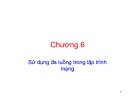
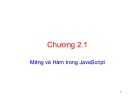
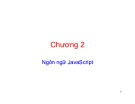


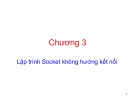

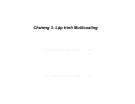

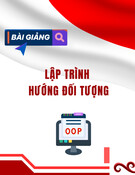
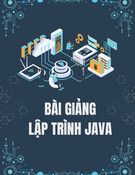
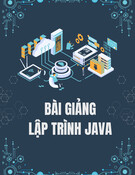
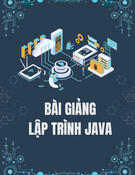
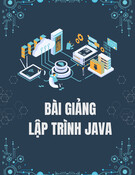
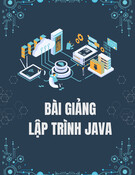
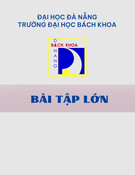
![Hệ thống quản lý cửa hàng bán thức ăn nhanh: Bài tập lớn [chuẩn nhất]](https://cdn.tailieu.vn/images/document/thumbnail/2025/20251112/nguyenhuan6724@gmail.com/135x160/54361762936114.jpg)
![Bộ câu hỏi trắc nghiệm Nhập môn Công nghệ phần mềm [mới nhất]](https://cdn.tailieu.vn/images/document/thumbnail/2025/20251111/nguyenhoangkhang07207@gmail.com/135x160/20831762916734.jpg)


